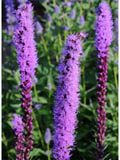
Highly adaptable and easy to grow. Attracts many butterflies, bees, and hummingbirds. A great Liatris for wet soils.
Dense gayfeather or marsh blazing star is an erect, slender perennial reaching a height of 3-4 ft. The linear, grass-like leaves are clumped toward the base of the plant, but extend up the stem to the showy flower cluster. A tall spike of rayless, rose-purple (sometimes white), closely set flower heads. The purple, tufted flower heads are arranged in a long, dense spike blooming from the top down.
The species name describes the elongated inflorescence, with its crowded, stalkless flower heads. The protruding styles give the flower an overall feathery appearance, hence its alternate name, Dense Gayfeather.
More from USDA Plants Database »